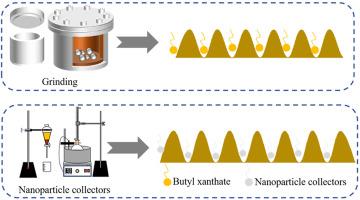New insights into enhancing sustainable flotation performance of fine chalcopyrite via surface modification
IF 4.3
2区 材料科学
Q2 ENGINEERING, CHEMICAL
引用次数: 0
Abstract
Copper, a critical strategic metal primarily from chalcopyrite, is widely used. However, a large amount of chalcopyrite is not effectively recovered resulting from its surface characteristics due to its fine size. This study introduced the use of surface roughness (SR) as a core indicator to evaluate chalcopyrite's flotation performance. Two modification methods including mechanical activation (grinding) and nanoparticle collectors (NPCs) modification were systematically investigated. Grinding enhanced SR from 1.274 to 3.593, improved yield from 55.14 % to 63.21 %, and increased hydrophobicity, as demonstrated by the rise in contact angle from 55.74° to 68.38°. NPCs demonstrated superior performance, with SR reaching 4.987, contact angle up to 90.75°, and yield as high as 91.45 %. The results demonstrated that physical modification (grinding) improved flotability through roughness enhancement, while NPCs offered an optimal solution for chalcopyrite flotation by combining the advantages of increased SR with strong collector interaction. Molecular dynamics simulations revealed the following diffusion coefficient order: CTAB (cetyltrimethylammonium bromide)-NPC > SDS (sodium dodecyl sulfate)-NPC > PEG (polyethylene glycol)-NPC > BX (butyl xanthate) > no collector. This trend demonstrated that higher water molecule mobility corresponded to reduced surface-water binding and enhanced chalcopyrite hydrophobicity induced by collector adsorption. These findings provide valuable insights for optimizing copper mineral processing, particularly for fine chalcopyrite resources.

通过表面改性提高细粒黄铜矿可持续浮选性能的新认识
铜是一种重要的战略金属,主要来自黄铜矿,用途广泛。但由于黄铜矿粒度细,其表面特性导致大量黄铜矿未能有效回收。采用表面粗糙度(SR)作为评价黄铜矿浮选性能的核心指标。系统研究了机械活化(研磨)和纳米颗粒捕集剂(NPCs)改性两种改性方法。磨削使SR从1.274提高到3.593,使收率从55.14%提高到63.21%,并使疏水性增强,接触角从55.74°增加到68.38°。NPCs表现出优异的性能,SR达到4.987,接触角高达90.75°,产率高达91.45%。结果表明,物理改性(磨矿)通过粗糙度的增强改善了黄铜矿的可浮性,而NPCs结合了SR的提高和强捕收剂相互作用的优势,为黄铜矿浮选提供了最佳解决方案。分子动力学模拟显示扩散系数顺序为:CTAB(十六烷基三甲基溴化铵)-NPC >; SDS(十二烷基硫酸钠)-NPC >; PEG(聚乙二醇)-NPC >; BX(丁基黄药)>;无捕收剂。这一趋势表明,更高的水分子迁移率与减少地表水结合和增强黄铜矿的疏水性相对应。这些发现为优化铜矿选矿,特别是细粒黄铜矿资源提供了有价值的见解。
本文章由计算机程序翻译,如有差异,请以英文原文为准。
求助全文
约1分钟内获得全文
求助全文
来源期刊

Particuology
工程技术-材料科学:综合
CiteScore
6.70
自引率
2.90%
发文量
1730
审稿时长
32 days
期刊介绍:
The word ‘particuology’ was coined to parallel the discipline for the science and technology of particles.
Particuology is an interdisciplinary journal that publishes frontier research articles and critical reviews on the discovery, formulation and engineering of particulate materials, processes and systems. It especially welcomes contributions utilising advanced theoretical, modelling and measurement methods to enable the discovery and creation of new particulate materials, and the manufacturing of functional particulate-based products, such as sensors.
Papers are handled by Thematic Editors who oversee contributions from specific subject fields. These fields are classified into: Particle Synthesis and Modification; Particle Characterization and Measurement; Granular Systems and Bulk Solids Technology; Fluidization and Particle-Fluid Systems; Aerosols; and Applications of Particle Technology.
Key topics concerning the creation and processing of particulates include:
-Modelling and simulation of particle formation, collective behaviour of particles and systems for particle production over a broad spectrum of length scales
-Mining of experimental data for particle synthesis and surface properties to facilitate the creation of new materials and processes
-Particle design and preparation including controlled response and sensing functionalities in formation, delivery systems and biological systems, etc.
-Experimental and computational methods for visualization and analysis of particulate system.
These topics are broadly relevant to the production of materials, pharmaceuticals and food, and to the conversion of energy resources to fuels and protection of the environment.
 求助内容:
求助内容: 应助结果提醒方式:
应助结果提醒方式:


